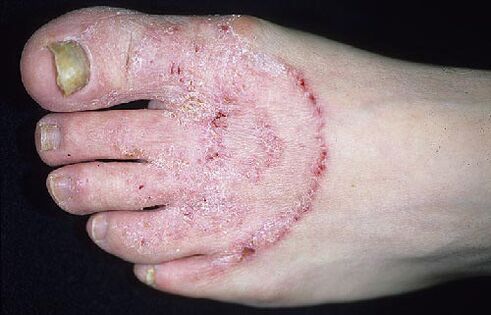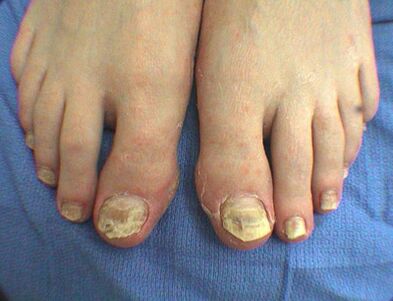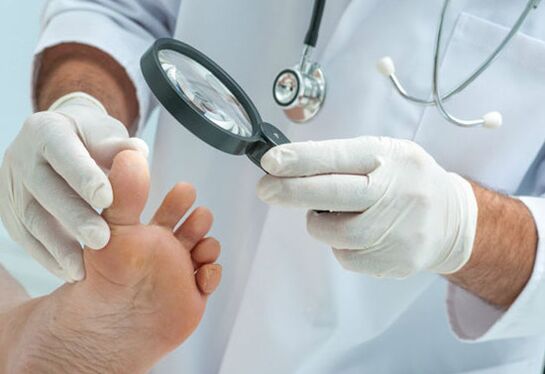Nail fungus (onychomycosis) is the most common disease in which nails turn yellow, become brittle and thick, are covered with cracks.In the initial stages, the symptoms of nail fungus are hardly noticed.The treatment of the disease is difficult due to impaired cellular immunity.The disease is slow, without proper treatment, progresses and can accompany the patient throughout his life.

More often, nail fungus is found in a person and people with weakened immunity.Patients with diabetes, obesity facing the pathology of blood vessels and skin diseases are the subject of illness.With high foot sweating, there is more chances for fungal damage to the skin of the feet and toenails.
The fungus can get on the nails of clothing, shoes, manicure sets, carpets, floor.It enters the nails through the micro -cracks of the skin and through the nails.It is very warm and humid: in souls, bathrooms, changing rooms and pools.In healthy people, the disease rarely develops.
The cause of the disease
Onychomycosis is caused by three types of fungi (one by one or in combination).Most cases of the disease are caused by rudrum trichopitone mushrooms.Much less often - Trichophyton Interdigitale, Epidermophyton Floccosum and Microsporum and Aspergillus.
- Candida albicans yeast fungus always parasitizes on the skin and nails.Taking antibiotics, contraceptives and reduction of immunity can develop yeast infection.
- Mold fungus often causes diseases in countries with tropical climate.
- Soil mushrooms live in the soil and cause onychomycosis only in some people.From person to person does not give up.
Who is the source of infection
- Family and friends diseases can become a source of pathogens for you.
The fungus is transmitted to the family through use by a simple towel, slippers, linen, etc. - Hand fungi can become a source of nail disease and skin skin.
- In a large number of fungi lives in bathrooms, shower and pools.
- The source of infection can be the patient's clothing and shoes, manicure kits, carpets and floors.
Which increases the risk of illness
- The fungus of the skin of the feet.
- Reducing immunity.
- Family members suffering from fungal lesions.
- Old age.
- Diabetes.
- The presence of micro -traumas and storms.
- Increased sweating of the legs.
- Unknown and bad -quality shoes.
- The habit of going barefoot in public places.
- Accommodation and work in a humid climate.
- Long -term wearing artificial nails.
Which affects the development and progression of onychomycosis
- General health.
- Sensitivity to infection.
- Moisture level and heat background.
- The nail appearance (finger nails grow more slowly).

Symptoms of nail fungus
At the beginning of the disease, the usual nail color changes.It becomes opaque.A gap in which the fungi themselves appear between him and his bed.
The nail is painted in one of the colors: whitish-gray, yellow, green and brown, to black.The yellow elongated stripes inside the nail and below it are visible.Spots of different shades.
The nails thicken and deform over the affected area.Horn masses grow gradually, preventing medication from penetrating.
Initially, increased gloom is noted, when the fungus affects the entire nail plate, it begins to fall apart and collapse.During processing, a large amount of garbage is formed, consisting of destroyed fragments and epidermis.There is often a skin damage around.
Onychomycosis
- Distal submarine onychomycosis.
- Lateral onychomycosis.
- Onychomycosis on the white surface.
- Proximal tray onychomycosis.
- General dystrophic onychomycosis.
A distal submarine and lateral onychomycosis
This form of the disease is the most common.Up to 90% of cases the cause is Trichophyton Rubrum mushrooms.Nail infection begins in the free edge of the affected skin of the foot.First, the nail bed is touched.The type of damage resembles cleavage or colored yellowish color.As the disease progresses, the nail thickens and can be split or separated from the skin.The distal submarine onychomycosis is difficult to treat.Wearing shoes causes discomfort.
Onychomycosis on the white surface
The second most common form of onychomycosis.In 90% of cases, the disease is caused by the genus of Trichophyton Interdigitale, which affects only the top layer of nails, which never thickens and is not separated from the skin.Over time, its entire surface becomes free, like chalk powder.The cure appears quickly.
Proximal tray onychomycosis
This form of onychomycosis is rare.Red trichophyte in the blood and lymphatic paths spread throughout the body.This is evidenced by the damage to the nail from the back (proximal) and the detection of the pathogen in the lymph nodes of the inguinal region and the secretion of the prostate gland.The disease is often recorded in HIV infected.The lesion begins with the skin in the area of nail folding, which thickens.In addition, the nail plate is involved in the process that becomes a white opaque color.
Common dystrophic onychomycosis
This form of the disease is a consequence of the progression of one or a set of species of the above forms of onychomycosis.The nails are partially or completely destroyed.
Diseases with similar symptoms

Of all infectious diseases, onychomycosis is found in 50% of cases.Similar symptoms have been found in the following diseases:
- Eczema.
- Psoriasis.
- Reuters Syndrome.
- Daria's disease.
- Flat lichen.
- Norwegian scabies.
Diagnosis of nail fungus
To get information on what has caused certain changes, you should consult a dermatologist who organizes the procedure for diagnosing the disease.The scraping from the affected part will be sent to the laboratory to clarify the causes of the disease.
Microscopy will identify the presence of a fungus, and sowing a nutrient medium will emphasize the pure culture of the pathogen and determine the sensitivity to antifungal drugs.
Before you begin treatment, it is necessary to identify the type of infection. The fungus of the toenails is easier to warn.Take a look at your legs and toenails more often.Early initiated treatment will help to quickly improve, reduce the feeling of discomfort and eliminate the cosmetic effect.

























